-Ragoo Rao
A very familiar sight around the tall minarets of Masjids and the spires of Churches, are the slate grey bird with glistening metallic green, magenta and purple sheen on their necks about the size of a crow. This is the common pigeon or the Blue Rock Pigeon
as it is rightly called.

The pigeons have no fear of man and they dwell very much inside bustling townships as long as their nesting and foraging requirements are met with. In fact these are the cousins of the earliest known Courier service pigeons. Both sexes look alike with their
grey body and two black bands on their wings and the tip of the tail. Their distribution is throughout the country and they inhabit both urban areas and the country side. The urban birds find niches and cornices of tall buildings for nesting while their country
cousins prefer cliffs and rocky bluffs for nesting.
These pigeons accept any feeding troughs and water baths provided by bird lovers and start living in a semi-wild condition. The main food of these birds are grains, cereals and pulses with a great liking for peanuts.
Pigeons bond into mating pairs for a long time and during the nest building and mating periods, its a familiar sight to see the males wooing the females with their Ghoooo...ghooooo...repeated calls and quietly flapping their wings to their sides. The aggressive
males can be seen around with their famous Gutrrrr...gooooo....gutrrrr....goooooo...calls with their crops fully blown up and rushing with their tails spread like fans, sweeping the floor. Nesting season is all round the year and not well defined, in the urban
birds and the country side birds nest when there is abundance of field crops close to harvest.
The nest is a loosely built platform of sticks or paddy hay where available and two white elliptical eggs are laid. Both sexes share all domestic chores including incubation. Incubation is for about 19 to 21 days and the chicks are blind covered with light
yellow downy feathers. The first few feeds for the hatchlings are of a gruel secretion from the parents known as the Pigeons milk. Later they are fed with grains regurgitated into their throats. The chicks are very voracious and they grow very fast. In about
three weeks time they can be seen as big as their parents but still begging for food from them.
A lovely bird which still exists right in the midst of urban areas but unless we respect them and keep track of their well being it may not be long before they take the WAY OUT like the House Sparrow. Nothing can bring them back.

( Photgraphs-Kabootharkhana, Dadar West, Mumbai by Susan Sharma; Blue Rock Pigeon by
Ragoo Rao)